NATO reported that it will send AWACS aircraft to Romania to conduct reconnaissance against the Russian Armed Forces By January 17, NATO will transfer AWACS aircraft to Romania to monitor "Russian military activity," the North Atlantic Alliance reported on Friday.
Previously, they were based at an air base in Gelsenkirchen in western Germany, and now they will be deployed in Otopeni near Bucharest, which will allow them to start conducting reconnaissance of Ukrainian airspace and the western part of the Black Sea almost immediately after takeoff. For more information, see the material "Newspapers.Ru".
NATO will deploy its AWACS long-range radar detection aircraft in Romania to conduct reconnaissance against Russia. This was announced on Friday, January 13, by the press service of the North Atlantic Alliance.
"NATO will send AWACS aircraft to Bucharest, Romania. The planes are due to arrive on January 17, 2023, and they will support NATO's expanded military presence in the region and monitor Russian military activity," the statement said.
The mission is designed for several weeks. At the same time, the number of aircraft is not disclosed.
According to the German agency DPA, we can talk about three planes. Previously, they were based at the Gelsenkirchen air base in western Germany, and now they will be deployed in Otopeni near Bucharest, which will allow them to start conducting reconnaissance of Ukrainian airspace and the western part of the Black Sea almost immediately after takeoff. According to sources in military circles, there are a total of 14 such aircraft in Germany.
Boeing E-3A AWACS long-range radar detection aircraft provide monitoring primarily of airspace. According to official technical specifications, they are capable of detecting and conducting aerial objects at a distance of up to 400 km, but they can also be used for reconnaissance of the ground situation, although with less efficiency.
"These NATO planes have been flying over the Black Sea on a regular basis since the reunification of Crimea with Russia and the beginning of the conflict in the Donbas in 2014.
Now the alliance intends to relocate three such aircraft to Romania on a long-term basis. NATO uses AWACS aircraft with the ability to refuel in the air, which significantly expands their range and time of duty in the air," writes TASS.
The alliance also clarified that "AWACS systems can detect aircraft at a distance of hundreds of kilometers, which makes them a key element for NATO deterrence and defense."
Earlier, Reuters reported that the United States is transferring military equipment to Eastern Europe as part of a rotation. Tanks and other military equipment of the US Army began arriving at the Dutch port of Vlissingen for shipment to Poland and Lithuania "as part of efforts to strengthen the eastern flank of NATO." It is specified that in total about 1250 units of equipment arrived at the port.
In August 2022, The Washington Post wrote that representatives of the countries on the eastern flank of the alliance asked the United States to speed up the supply of weapons to them, fearing that "they will be the next to be attacked." They believe that Russia poses an existential threat to the West, and in the long term, NATO should become more aggressive. According to their estimates, the expansion of the American presence in Europe is necessary in order to "keep Moscow at bay."
How NATO is expanding
NATO is a military alliance, the organization of which constitutes a system of collective defense. Countries wishing to join the bloc must meet certain requirements and go through a multi-step process that includes political dialogue and military integration.
At the moment, the North Atlantic Alliance has gone through seven stages of expansion. In 1990, with the unification of Germany, the territory of the alliance expanded to the lands of the former GDR. During the unification negotiations, an agreement was reached that foreign (non-German) troops would not be deployed on the territory of the former GDR, and, presumably, an oral agreement on the non-expansion of NATO to the east.
In 1994, it was decided to admit the former republics of the USSR and the member states of the Warsaw Pact Organization to NATO. Bill Clinton, then President of the United States, said in January 1994 that such a decision could become a "self-fulfilling prophecy" and lead to the "alienation" of Russia.
Grigory Plakuchev

